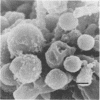Abstract
Serratia marcescens was easily induced to form spheroplasts by beta-lactam antibiotics in the presence of Ca2+ or Mg2+ without an osmotic stabilizer such as sucrose. The spheroplasts grew in volume, although they could not divide. They were stable for more than 10 h at 37 degrees C in a medium containing a high concentration of antibiotic, and they had the ability to revert to the original bacillary form. Ca2+ was more effective in spheroplast induction than Mg2+. The effect was proportional to the concentration of cations. In 40% of 180 clinical isolates of S. marcescens, more than 40% of the original bacterial cells were induced to form spheroplasts by ceftizoxime in a medium supplemented with 40 mM Ca2+. A high spheroplast induction rate was observed even in medium with 10 mM Ca2+. Few isolates that were supersusceptible to ceftizoxime (MIC, less than 0.2 microgram/ml) were induced to form spheroplasts at a high rate. No difference in spheroplast induction rate or extent between antibiotic-resistant strains and relatively susceptible strains (MIC, greater than 0.2 microgram/ml) was found. The serotype of S. marcescens had no effect on the spheroplast induction rate. Monocations (Na+ and K+) had little effect on spheroplast induction.
Full text
PDF




Images in this article
Selected References
These references are in PubMed. This may not be the complete list of references from this article.
- Furutani A., Tada Y., Yamaguchi J. Reversion to bacillary forms of Serratia marcescens spheroplasts induced by carbenicillin. Scanning electron microscopic study. Microbiol Immunol. 1985;29(10):901–907. doi: 10.1111/j.1348-0421.1985.tb02955.x. [DOI] [PubMed] [Google Scholar]
- GUZE L. B., KALMANSON G. M. PERSISTENCE OF BACTERIA IN "PROTOPLAST" FORM AFTER APPARENT CURE OF PYELONEPHRITIS IN RATS. Science. 1964 Mar 20;143(3612):1340–1341. [PubMed] [Google Scholar]
- Geiseler P. J., Harris B., Andersen B. R. Nosocomial outbreak of nitrate-negative Serratia marcescens infections. J Clin Microbiol. 1982 Apr;15(4):728–730. doi: 10.1128/jcm.15.4.728-730.1982. [DOI] [PMC free article] [PubMed] [Google Scholar]
- HAROLD F. M. STABILIZATION OF STREPTOCOCCUS FAECALIS PROTOPLASTS BY SPERMINE. J Bacteriol. 1964 Nov;88:1416–1420. doi: 10.1128/jb.88.5.1416-1420.1964. [DOI] [PMC free article] [PubMed] [Google Scholar]
- John J. F., Jr, McNeill W. F. Characteristics of Serratia marcescens containing a plasmid coding for gentamicin resistance in nosocomial infections. J Infect Dis. 1981 Jun;143(6):810–817. doi: 10.1093/infdis/143.6.810. [DOI] [PubMed] [Google Scholar]
- Kaye D. Host defense mechanisms in the urinary tract. Urol Clin North Am. 1975 Oct;2(3):407–422. [PubMed] [Google Scholar]
- Landman O. E., Forman A. Gelatin-induced reversion of protoplasts of Bacillus subtilis to the bacillary form: biosynthesis of macromolecules and wall during successive steps. J Bacteriol. 1969 Aug;99(2):576–589. doi: 10.1128/jb.99.2.576-589.1969. [DOI] [PMC free article] [PubMed] [Google Scholar]
- Landman O. E., Ryter A., Fréhel C. Gelatin-induced reversion of protoplasts of Bacillus subtilis to the bacillary form: electron-microscopic and physical study. J Bacteriol. 1968 Dec;96(6):2154–2170. doi: 10.1128/jb.96.6.2154-2170.1968. [DOI] [PMC free article] [PubMed] [Google Scholar]
- Okuda T., Endo N., Osada Y., Zen-Yoji H. Outbreak of nosocomial urinary tract infections caused by Serratia marcescens. J Clin Microbiol. 1984 Oct;20(4):691–695. doi: 10.1128/jcm.20.4.691-695.1984. [DOI] [PMC free article] [PubMed] [Google Scholar]
- Penn R. G., Preheim L. C., Sanders C. C., Giger D. K. Comparison of moxalactam and gentamicin in the treatment of complicated urinary tract infections. Antimicrob Agents Chemother. 1983 Oct;24(4):494–499. doi: 10.1128/aac.24.4.494. [DOI] [PMC free article] [PubMed] [Google Scholar]
- Platt D. J., Sommerville J. S. Serratia species isolated from patients in a general hospital. J Hosp Infect. 1981 Dec;2(4):341–348. doi: 10.1016/0195-6701(81)90066-9. [DOI] [PubMed] [Google Scholar]
- RAZIN S. FACTORS INFLUENCING OSMOTIC FRAGILITY OF MYCOPLASMA. J Gen Microbiol. 1964 Sep;36:451–459. doi: 10.1099/00221287-36-3-451. [DOI] [PubMed] [Google Scholar]
- Rodwell A. W. The stability of Mycoplasma mycoides. J Gen Microbiol. 1965 Aug;40(2):227–234. doi: 10.1099/00221287-40-2-227. [DOI] [PubMed] [Google Scholar]
- Sanders C. C., Watanakunakorn C. Emergence of resistance to beta-lactams, aminoglycosides, and quinolones during combination therapy for infection due to Serratia marcescens. J Infect Dis. 1986 Mar;153(3):617–619. doi: 10.1093/infdis/153.3.617. [DOI] [PubMed] [Google Scholar]
- Sifuentes-Osornio J., Ruiz-Palacios G. M., Gröschel D. H. Analysis of epidemiologic markers of nosocomial Serratia marcescens isolates with special reference to the Grimont biotyping system. J Clin Microbiol. 1986 Feb;23(2):230–234. doi: 10.1128/jcm.23.2.230-234.1986. [DOI] [PMC free article] [PubMed] [Google Scholar]
- Tabor C. W. STABILIZATION OF PROTOPLASTS AND SPHEROPLASTS BY SPERMINE AND OTHER POLYAMINES. J Bacteriol. 1962 May;83(5):1101–1111. doi: 10.1128/jb.83.5.1101-1111.1962. [DOI] [PMC free article] [PubMed] [Google Scholar]
- Tada Y., Yamaguchi J. Necessity for De Novo DNA synthesis for reversion of Escherichia coli spheroplasts to bacillary forms. Microbiol Immunol. 1983;27(10):893–896. doi: 10.1111/j.1348-0421.1983.tb00653.x. [DOI] [PubMed] [Google Scholar]
- Tompkins L. S., Plorde J. J., Falkow S. Molecular analysis of R-factors from multiresistant nosocomial isolates. J Infect Dis. 1980 May;141(5):625–636. doi: 10.1093/infdis/141.5.625. [DOI] [PubMed] [Google Scholar]
- Yu V. L. Enterococcal superinfection and colonization after therapy with moxalactam, a new broad-spectrum antibiotic. Ann Intern Med. 1981 Jun;94(6):784–785. doi: 10.7326/0003-4819-94-6-784. [DOI] [PubMed] [Google Scholar]



